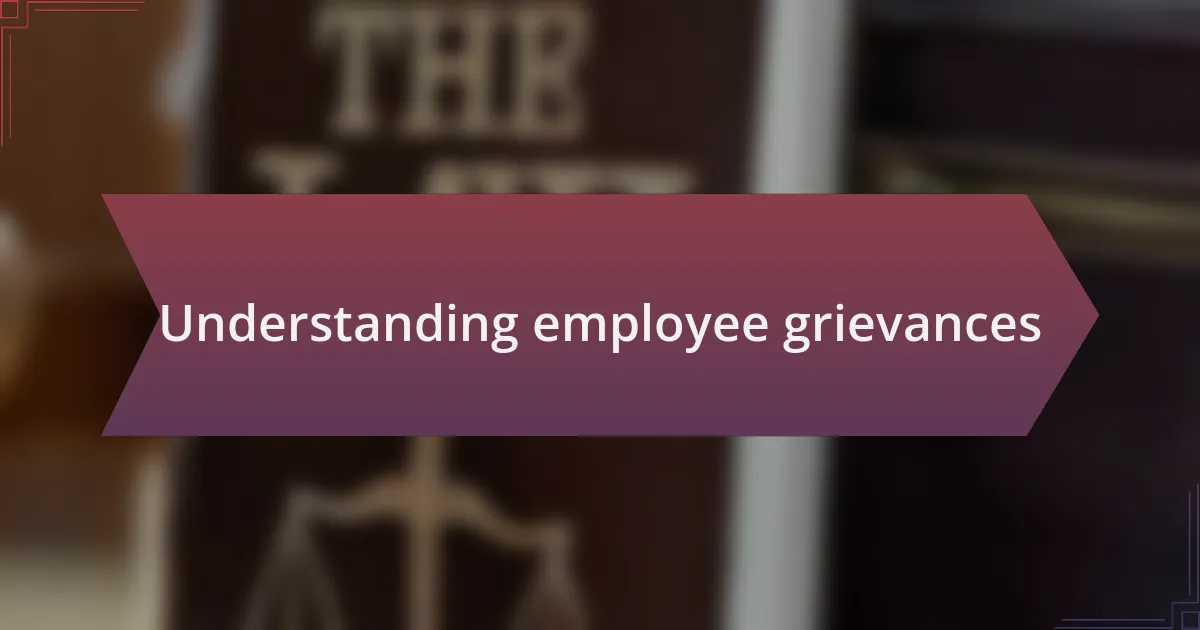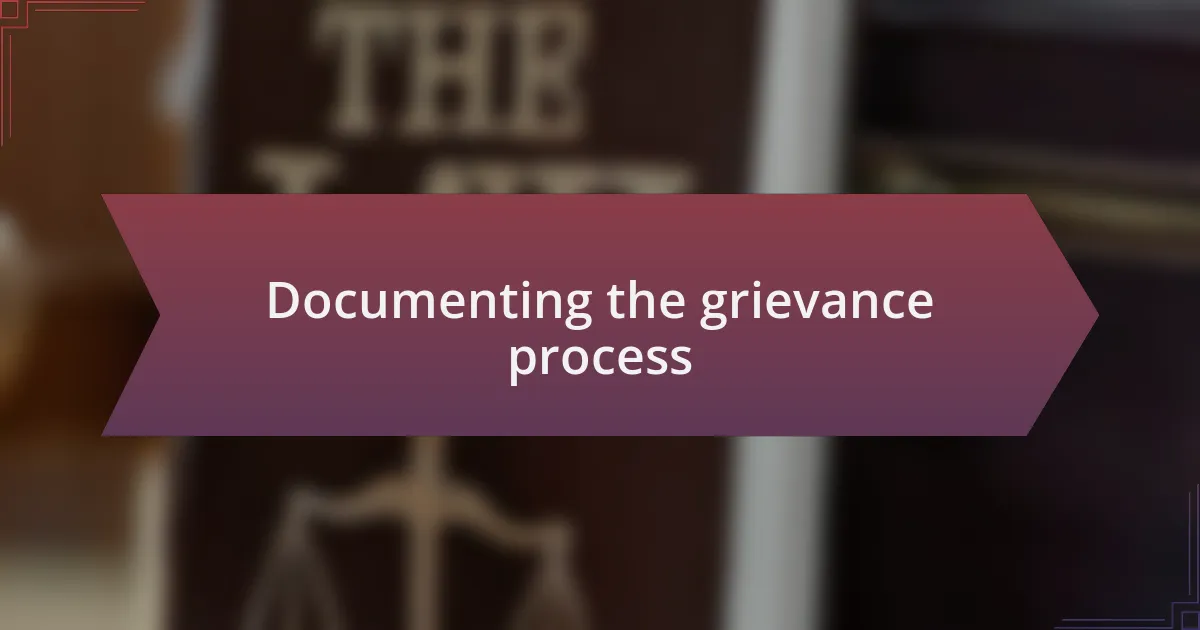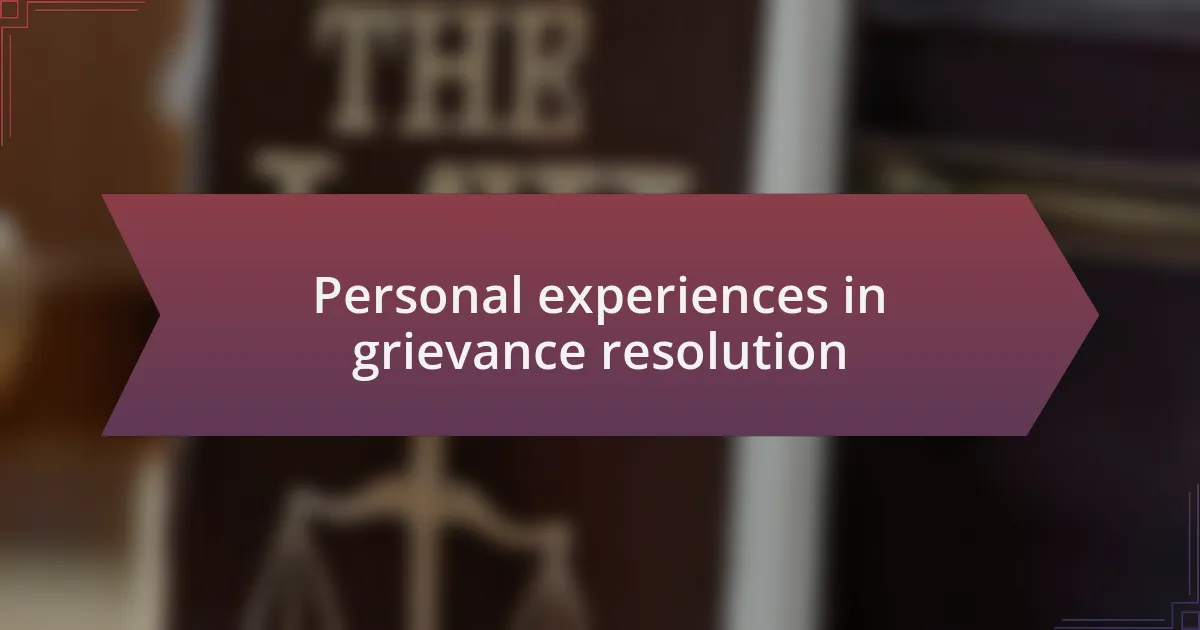Key takeaways:
- Employee grievances reflect deeper issues, often stemming from feelings of being unheard or undervalued.
- Listening with empathy and maintaining an open-door policy fosters a culture of trust and resolution.
- Documenting grievances and following legal frameworks enhances transparency, accountability, and effective management of complaints.
- Consistent follow-up after addressing grievances is crucial for sustained improvement and employee support.

Understanding employee grievances
Employee grievances are more than just formal complaints; they are often reflections of deeper issues within an organization. When I first encountered a grievance from a team member, I realized this wasn’t just about the specific problem at hand, but rather a signal that the employee felt unheard and undervalued. How often do we overlook these subtle indicators in our workplace?
During one of my previous roles, I faced a situation where an employee felt continuously overlooked for promotions. It became clear to me that grievances could arise from feelings of injustice, not just from tangible workplace conflicts. I started to understand that, if not addressed, these grievances can severely impact morale and productivity.
I’ve learned that listening with empathy is crucial. When I took the time to meet with the concerned employee, I wasn’t just addressing their issue; I was fostering a culture of openness. Have you ever considered how a simple conversation could transform not only a relationship but also the climate of an entire team? It’s these moments that reinforce the importance of acknowledging grievances promptly and compassionately.

Legal framework for grievances
The legal framework for addressing employee grievances is grounded in various employment laws and regulations. For instance, laws such as the Equal Employment Opportunity Commission (EEOC) guidelines ensure that grievances related to discrimination are taken seriously. I remember when I first had to navigate a complaint regarding perceived discrimination; it was daunting to sift through regulations, but understanding this framework empowered me to manage the situation effectively.
Moreover, many organizations have their own grievance procedures outlined in employee handbooks, which not only provide a clear process for employees to voice their concerns but also ensure that employers comply with legal requirements. I recall a time when I addressed a grievance related to unfair treatment, and referring to our internal policy helped me to guide the conversation and resolve the issue in a structured manner. It made me appreciate how these protocols can facilitate conversations and ensure fairness.
It’s also crucial to recognize that some legal requirements vary by state or country, adding another layer of complexity to grievance handling. When I dealt with a multi-state team, I had to be especially diligent in understanding the specific laws applicable to each location. Have you ever found yourself handling a grievance without knowing all the legal implications? It can be challenging, but being informed truly enhances our ability to engage constructively.

Best practices for addressing grievances
Addressing employee grievances effectively requires an open-door policy that encourages candid communication. I’ve often found that fostering a culture of trust makes a significant difference. For instance, when a team member approached me with concerns about workload distribution, I made it a point to listen actively, validating their feelings and showing empathy. It’s amazing how a simple acknowledgement can pave the way for a constructive dialogue.
Another best practice is to document all grievance conversations and resolutions. This not only provides a clear record but also demonstrates to employees that their concerns are taken seriously. I recall a situation where I documented a discussion about harassment, and having a written account proved invaluable when we formulated a follow-up action plan. Do you see the value in maintaining such records? It elevates transparency and accountability in the workplace.
Timeliness in addressing grievances cannot be overstated. When I delayed action on a reported issue, the frustration of the employee grew, which only complicated the situation. It taught me the importance of a swift response; people want to feel heard and to see that their concerns are addressed promptly. Wouldn’t you agree that acting quickly shows commitment to resolving issues and supports a healthier work environment?

Steps to investigate grievances
When it comes to investigating grievances, the first step I take is to gather all relevant information. I remember a time when an employee raised concerns about unfair treatment in project assignments. I sat down with them, asking targeted questions to get a clear view of their experiences. This initial conversation helped me understand the specific incidents that needed further exploration.
Following that, I always ensure to talk to other involved parties. In one instance, different perspectives illuminated issues I hadn’t considered. Engaging with everyone involved not only enriches the investigation but also helps promote fairness. Isn’t it fascinating how diverse viewpoints can uncover underlying issues that may not be immediately apparent?
After gathering information, I make sure to compile my findings coherently. This step is crucial because it forms the basis for any decisions made afterwards. By producing a clear report outlining the grievance, findings, and proposed actions, I ensure that there is a transparent record of the process. That way, when discussing resolutions, everyone feels confident that the steps taken are justified and well thought out. Don’t you think that clarity in documentation can serve as a safeguard for both the employee and the employer?

Communicating with employees effectively
Effective communication with employees is vital during the grievance process. I recall a situation where an employee felt isolated in a team setting. I made it a point to check in regularly and created a safe space for them to express their concerns. By actively listening and responding with empathy, I not only gained their trust but also encouraged open dialogue. Isn’t it amazing how fostering a sense of belonging can transform an employee’s experience?
Another aspect I prioritize is being approachable. There was a time when I hosted informal coffee hours specifically to promote discussion of any workplace issues. This relaxed setting allowed employees to bring up their grievances without the pressure of a formal meeting. I found that many employees appreciated this initiative, resulting in candid conversations that led to quick resolutions. Can we all agree that sometimes the right environment can make all the difference in how employees communicate their feelings?
Lastly, I emphasize the importance of consistent follow-up after an initial grievance discussion. Once, I had an employee voice concerns over workload distribution, and I promised to revisit the topic after a month. Keeping that promise not only demonstrated my commitment but also allowed us to reassess the situation together. How often do we reflect on unresolved issues, only to find that consistent check-ins can pave the way for sustained improvement?

Documenting the grievance process
Documenting the grievance process is crucial, as it creates a clear record of the issues and resolutions discussed. I remember a time when I meticulously noted each conversation with an employee about their concerns. This attention to detail not only helped me keep track of progress but also served as a protective measure for both the employee and the organization. Isn’t it comforting to know that having a written record can support clarity and accountability?
I’ve found that using a standardized form for grievances can simplify this documentation effort significantly. After implementing a form, I noticed that employees felt more empowered to voice their concerns, knowing there was a structured way to address them. Have you ever considered how a simple template can make it easier for employees to articulate their grievances?
Moreover, I believe it’s essential to emphasize confidentiality in the documentation process. One time, an employee confided in me about a sensitive matter, and I took great care to ensure their privacy was respected in every written record. When employees trust that their concerns will be handled discreetly, they are more likely to share openly. How important do you think it is to foster that level of trust in a workplace?

Personal experiences in grievance resolution
There was a particular incident that stands out in my mind, where an employee approached me with a grievance about team dynamics. As I listened to their concerns, I realized how deeply they felt unheard and marginalized. It made me reflect on the power of active listening, not just as a management tool but as a means to validate someone’s experience. Have you ever noticed how simply feeling heard can shift someone’s perspective on a situation?
In another situation, I encountered a grievance that revolved around unclear job expectations. I arranged a meeting with the employee to discuss their role, and to my surprise, they opened up about their frustrations regarding unclear communication from management. This encounter taught me how essential it is to cultivate an environment where expectations are transparent. How often do we assume clarity when, in reality, it may be a foggy area for our team members?
I also recall a time when a follow-up was key to resolving a grievance. After addressing an employee’s concern about work-life balance, I made it a point to check in with them regularly. Their relief was palpable, as they felt supported and valued. I couldn’t help but feel a sense of fulfillment knowing I played a role in turning their experience around. Isn’t it incredible how a little ongoing support can transform a situation?